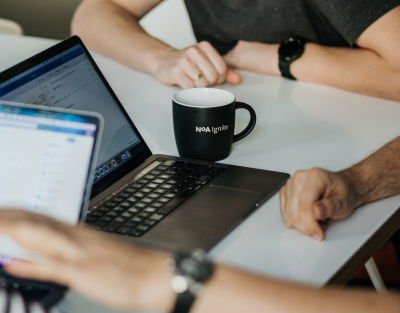The use of video has spread like a wildfire online in the last few years. “People don’t read anymore” has become a common statement and companies invest in fancy graphics like never before. Are words becoming less important and should we therefore write less?
The internet is text-driven
No matter how popular and useful videos are, the fact remains that information on the internet is driven by text. Not the least because Google and other search engines need text to understand what a website is about – so websites without a substantial amount of copy will get a low rank in search.
Moreover, the internet may have changed how we read, but it hasn’t changed the fact that we read. We do, however, demand that text is presented to us in a visually pleasing, easy-to-digest format. Hence as long as we pay attention to the presentation, we should not write less but rather write more.
Endless possibilities
All texts have a visual aspect. Even in a standard word document without images, the formatting has simply been decided for us before we start typing (font Times New Roman, size 12). We will probably add a heading and subheadings, and perhaps some bold, italics or bullet points. The only difference online is that the possibilities of how we present text are endless.
Working as a web writer has taught me that it is not good enough to produce text in isolation. No text belongs in a vacuum, and nowhere is this truer than online. All text we produce will be inserted on a page where it has to fight for attention with all the other elements – links, images, adverts, forms, play buttons…
Does this mean that writers now have to be designers too? Well no, because that would be unreasonable. It is however a very good idea for writers and designers to collaborate. And it doesn’t hurt to take aninterest in design principles. I found this article about how to visually group information on a page interesting.
From scanning to reading
It is often said that we don’t read so much online but rather scan for information. That’s a good point. At the same time, text-based blogs are thriving business, and I’m sure I’m not the only one who actually reads articles on my mobile phone. In a report from 2013, Technorati found that “with regards to overall sources for information on the internet, blogs rank among the top five ‘most trustworthy’ sources” (http://technorati.com/report/2013-dir/).
I would say that we start by scanning a page – we search for relevant content in titles, introductions and subheadings – perhaps we even scroll down to have a peek at the conclusion or summary. What we are looking for is an answer to the question “is this page worth my time”? If the answer to that question is yes, we may scroll to the top and actually read the body text.
Tips for web editors everyone who publishes anything online
- As people tend to be impatient online, try to write concisely and to the point. No waffling, in other words
- Present information in bite-sized chunks
- Remember headings and sub-headings
- Use a balanced mix of media where possible
- Bullet points are hot
- Write in plain language – unless you are writing exclusively for subject experts, drop the jargon. Or at the very least, explain the jargon – and if so, make sure it is visually pleasing (use a nicely coloured fact box, for instance).
- Oh yes, don’t forget nicely coloured fact boxes
Here is an example of a website with a great fusion of text and visuals to aid learning: https://school.bighistoryproject.com/bhplive
Conclusion
The internet, with all its possibilities of using a mish-mash of text, pictures, sound and video puts great demands on text, but it would be a mistake to think that text is no longer required or desired. If we want readers, we have to pay attention to looks. Put bluntly, it pays off to be shallow.
Author

Anja Wedberg
Senior Content Editor
Anja is a Senior Content Editor with a background in translation, marketing and web publishing. She spends most of her spare time fighting, either with new karate moves or with Polish consonant clusters. Check out the rest of her blog articles at medium.com/anja.
Related articles
![A well-crafted prompt doesn’t just work once. It works across teams, channels, and campaigns. It can be tweaked for new use cases and refined based on what performs best.]()
June 27, 2025 / 4 min read
Prompts are marketing assets: how to reuse, and scale them
Prompts aren’t throwaway lines. They’re repeatable, scalable assets that can streamline your marketing your team’s output. Learn how to build a prompt library that delivers.
![Woman using a wheelchair in the office settings]()
June 17, 2025 / 5 min read
What is accessibility and why it matters?
Accessibility ensures everyone — including those with disabilities or limitations — can read, navigate, and engage with your content equally.



